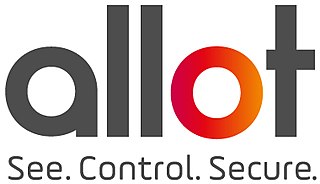Voice over Internet Protocol (VoIP), also called IP telephony, is a method and group of technologies for voice calls for the delivery of voice communication sessions over Internet Protocol (IP) networks, such as the Internet.
Telkom SA SOC Limited is a South African wireline and wireless telecommunications provider, operating in more than 38 countries across the African continent. Telkom is majority state-owned (55.3%) with the South African government owning 40.5% of Telkom, while another 14.8% is owned by another state-owned company - the Public Investment Corporation (PIC), which is closely linked to the South African government.

Allot Ltd., formerly Allot Communications, is an Israeli high-tech company that develops telecommunications software. The company is headquartered in Hod Hasharon, Israel.
A service delivery platform (SDP) is a set of components that provides a service(s) delivery architecture for a type of service delivered to consumer, whether it be a customer or other system. Although it is commonly used in the context of telecommunications, it can apply to any system that provides a service. Although the TM Forum (TMF) is working on defining specifications in this area, there is no standard definition of SDP in industry and different players define its components, breadth, and depth in slightly different ways.
Mobile VoIP or simply mVoIP is an extension of mobility to a voice over IP network. Two types of communication are generally supported: cordless telephones using DECT or PCS protocols for short range or campus communications where all base stations are linked into the same LAN, and wider area communications using 3G or 4G protocols.

In telecommunications, a femtocell is a small, low-power cellular base station, typically designed for use in a home or small business. A broader term which is more widespread in the industry is small cell, with femtocell as a subset. It typically connects to the service provider's network via the Internet through a wired broadband link ; current designs typically support four to eight simultaneously active mobile phones in a residential setting depending on version number and femtocell hardware, and eight to sixteen mobile phones in enterprise settings. A femtocell allows service providers to extend service coverage indoors or at the cell edge, especially where access would otherwise be limited or unavailable. Although much attention is focused on WCDMA, the concept is applicable to all standards, including GSM, CDMA2000, TD-SCDMA, WiMAX and LTE solutions.
Chikka, short for Chikka Text Messenger, was an Internet-based instant messaging application that supported free SMS or text messaging between online users and offline mobile subscribers. Chikka was released by Chikka Philippines, Inc. in the early 2000 and eventually established its connection with the country's network operators Smart Communications (2001), Globe Telecom (2002) and Sun Cellular (2004). With up to billions of messages being exchanged between online and mobile communities worldwide through Chikka, it is probably the world's first commercially successful integration of web and mobile utilities.

Ovi by Nokia was the brand for Nokia's Internet services. The Ovi services could be used from a mobile device, computer or via the web. Nokia focused on five key service areas: Games, Maps, Media, Messaging and Music. Nokia's aim with Ovi was to include third party developers, such as operators and third-party services like Yahoo's Flickr photo site. With the announcement of Ovi Maps Player API, Nokia started to evolve their services into a platform, enabling third parties to make use of Nokia's Ovi services.
On-Device Portals (ODPs) allow mobile phone users to easily browse, purchase and use mobile content and services. An ODP platform enables operators to provide a consistent and branded on-device experience across their broadening portfolio of services and typically provides on-device catalogs of content for purchase, deep links to WAP portals, customer care functionality and rich media services such as full track music, TV and video.

Cloud computing is the on-demand availability of computer system resources, especially data storage and computing power, without direct active management by the user. Large clouds often have functions distributed over multiple locations, each of which is a data center. Cloud computing relies on sharing of resources to achieve coherence and typically uses a pay-as-you-go model, which can help in reducing capital expenses but may also lead to unexpected operating expenses for users.

Ribbit was a telecommunications company based in Mountain View, California. It was acquired by BT Group on July 29, 2008 for $105 million.
Novarra was a mobile internet software company founded in 2000 and based in Itasca, Illinois, United States. It created web-based services such as web internet access, portals, videos, widgets and advertising for mobile devices. Novarra provided access to the internet and other services through wireless handsets, PDAs and laptops and sold directly to operators, mobile handset manufacturers and internet brand companies. In 2010, Nokia acquired 100% of Novarra's shares.
Network intelligence (NI) is a technology that builds on the concepts and capabilities of deep packet inspection (DPI), packet capture and business intelligence (BI). It examines, in real time, IP data packets that cross communications networks by identifying the protocols used and extracting packet content and metadata for rapid analysis of data relationships and communications patterns. Also, sometimes referred to as Network Acceleration or piracy.
Mob4Hire is a privately held Canadian Web 2.0 company. It primarily provides crowd-sourced mobile application testing services. It also conducts market research in the global wireless telephony space.
Tiered service structures allow users to select from a small set of tiers at progressively increasing price points to receive the product or products best suited to their needs. Such systems are frequently seen in the telecommunications field, specifically when it comes to wireless service, digital and cable television options, and broadband internet access.
Telecommunications billing is the group of processes of communications service providers that are responsible to collect consumption data, calculate charging and billing information, produce bills to customers, process their payments and manage debt collection.
Net bias is the counter-principle to net neutrality, which indicates differentiation or discrimination of price and the quality of content or applications on the Internet by ISPs. Similar terms include data discrimination, digital redlining, and network management.
ItsOn was an American software company based in Redwood City, California that developed cloud computing software for enhancing the performance of mobile networks. ItsOn's software platform gave mobile network operators the ability to offer granular and flexible, user-customizable services. Users could select and change mobile voice, text, and data services, as well as manage devices, plan sharing and permissions, directly from smart devices at any time.
Multi-access edge computing (MEC), formerly mobile edge computing, is an ETSI-defined network architecture concept that enables cloud computing capabilities and an IT service environment at the edge of the cellular network and, more in general at the edge of any network. The basic idea behind MEC is that by running applications and performing related processing tasks closer to the cellular customer, network congestion is reduced and applications perform better. MEC technology is designed to be implemented at the cellular base stations or other edge nodes, and enables flexible and rapid deployment of new applications and services for customers. Combining elements of information technology and telecommunications networking, MEC also allows cellular operators to open their radio access network (RAN) to authorized third parties, such as application developers and content providers.




